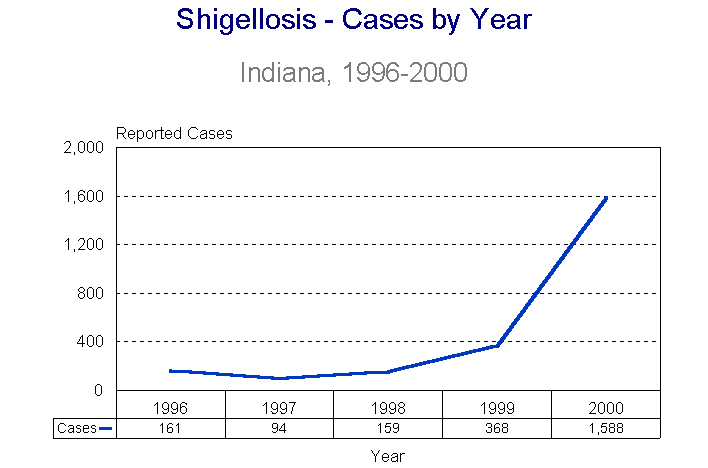
2000 Indiana Report of Infectious Diseases |
View ISDH's Quick Facts on Shigellosis
View CDC's Shigellosis page
Rates presented are per 100,000 population and are based on the U.S. 2000 Census.
| Cases | Incidence Rate |
|
| Total | 1,588 | 26.1 |
| Race-specific cases and rates1 | ||
| White | 418 | 7.9 |
| Black | 809 | 158.6 |
| Other2 | 7 | *2.8 |
| Sex-specific cases and rates3 | ||
| Female | 865 | 27.9 |
| Male | 714 | 23.9 |
Shigellosis is a bacterial disease usually transmitted from person-to-person through hands contaminated with feces. It can also be transmitted through food and water contaminated with human feces or through oral-anal contact. Shigellosis is highly communicable, as only 10-100 organisms must be ingested to establish infection.
In 2000, 1,588 cases of shigellosis were reported in Indiana, over four times the number of cases reported in 1999 (Figure Shg1). This is the third consecutive year that the incidence of shigellosis infection has increased. Shigellosis incidence generally varies within a 5 to 6 year cycle. The 2000 incidence was particularly high due to several reported outbreaks, including an exceptionally large outbreak in Marion County.
There are four Shigella species, all of which infect only humans and primates. The serotype was determined for 1,507 (95%) of the 1588 reported shigellosis cases. Shigella sonnei accounted for 1487 cases (98.7%), 18 were S. flexneri (1.2%), and 2 (0.1%) were S. boydii. There were no reported cases of S. dysenteriae.
Incidence of shigellosis peaked during the spring months (Figure Shg2). Cases in females (27.9/100,000 population) were more likely to be reported than in males (23.9). The rate of illness among blacks was (158.6) over 20 times higher than whites (7.9), due in large part to the Marion County outbreak.
Age-specific rates were highest among children ages 1-4 (184.5/100,000 population), followed by children ages 5-9 (101.7) (Figure Shg3). These high age-specific rates of shigellosis among preschool-aged and elementary school-aged children represent the increasing problem of shigellosis outbreaks in day-care centers and elementary schools, primarily grade 1 and lower. Among counties with at least 5 cases reported, the incidence rate was highest in Marion (146.0), Warren (71.3), Morgan (27.0), Elkhart (23.0), and Knox (22.9) Counties.
Four outbreaks of shigellosis occurred in 2000. The causative agent for all of these was confirmed as Shigella sonnei. As stated earlier, the most significant outbreak occurred in Marion County. Beginning in January and peaking in May, over 1,200 cases were identified throughout the year, particularly in children attending day-care centers and elementary schools and their contacts. The outbreak had greatly diminished by the end of 2000 but had not completely resolved. During June and July, an outbreak occurred at an Allen County day-care center. Cases included at least 32 children and 5 staff members. In July and August, an Elkhart County daycare center experienced an outbreak, with at least 10 children becoming ill. At least 9 students and staff at a Morgan County elementary school developed shigellosis during September and October. Shigella can be transmitted both through foodborne and person-to-person routes, however, all of these outbreaks were attributed to person-to-person transmission.
Back to Top of Article
Back to Table of Contents
|
|
Back to Reference in Text
Back to Top of Article
|
|
Back to Reference in Text
Back to Top of Article
|
Figure Shg3: Shigellosis - Incidence Rate by Age Group, Indiana, 2000 |
|
|
Back to Reference in Text
Back to Top of Article
1 - Race was unknown for 354 of the reported cases.
2 - "Other" includes American Indian/Alaska Native, Asian, Native Hawaiian/Pacific Islander, and multiracial.
3 - Sex was unknown for 9 of the reported cases.
* - Rate based on less than 20 cases and should be considered unstable.
Back to Table of Contents
[an error occurred while processing this directive]